











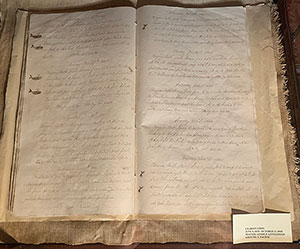
Whaling Log of the Ship Chariot, c. 1839‑40
The original ship’s log of a whaling trip to the South Pacific from June 9, 1839 – October 13, 1840. Bound in sailcloth. 121 pp. The Master of the Chariot was George Littlefield.
The top two entries read:
Sunday Jan 26th 1840: Begins with fresh breezes from NE and pleasant weather. Steering NW x W with all sails set. At 6pm spoke to ship Janus of New Bedford. Took in sail, middle part rainy. At 8am made all sail. At 9 saw whales lored and took two and took them alongside. Later part thick weather. Latt. by acct. 44.20.
Monday, Jan 27th 1840: Begins with fresh breezes from SSE and thick weather. At 3 began to cut. At sunset, finished cuting and took in sail. Middle part rainy. At daylight set all sail and began to boil, at 7am saw whales lored and took two. Took them alongside and began to cut. Later part calm. Latt by obs. 43.56
Each day has 2 whale stamps, indicating the capture of four whales.
----------------
Warren was a major whaling port and shipbuilding center from 1760 through the 1860s. 23 vessels were operating out of Warren between 1825 and 1857, seven of which were built in Warren. The Chariot was built in Newbury, Mass in 1823, owned in Warren from 1832 until, its fifth whaling venture in in 1847. Whales were treasured for the value of their oil, the most precious coming from the sperm whale. The largest amount of sperm oil ever returned to Warren was on the Chariot, which came back with 2,300 barrels of sperm oil in 1834. No other Warren whaler ever gathered more than 2000 barrels of this oil. The library museum also has the logbook from the ship’s store aboard the Chariot detailing the names of the sailors and their purchases.
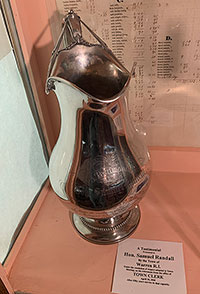
Samuel Randall Pitcher, c. 1860
Testimonial Gorham Sterling Silver Pitcher presented to Hon. Samuel Randall by the Town of Warren, RI under the resolution of respect adopted in Town Meeting, on his retirement from the office of Town Clerk on April 18, 1860, after fifty years in that capacity.
Samuel Randall (1778-1864) was born in Sharon, MA and attended Brown University, graduating in 1804. He studied law before moving to Warren, where he took charge of a school before entering the printing business and becoming postmaster, a position he held from 1811‑1845. In 1813, Randall started the Telescope, Warren’s third newspaper. In 1822, he became a judge in the Court of Common Pleas and in 1824 he was made one of the Justices of the Rhode Island Supreme Court, remaining in that position until 1832. Judge Randall lived at 31 Baker Street, where his post office and the Town Clerk’s offices were located.
He served as Warren’s Town Clerk, retiring in 1860 after 50 years of service. His life, marked by constant activity, ended on March 5, 1864.
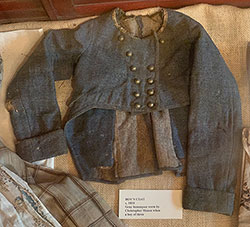
Boy’s Coat, c. 1810
A soldier coat for a boy three years of age, worn 1807, made of strong, grey-mixed homespun and ornamented with brass buttons. It was worn by Capt. Christopher Mason when 3 years of age. He was born in Swansey 1807. Presented to the Museum by W. J. McKenzie in 1894.
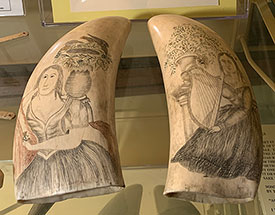
Scrimshaw: Matched Pair of Sperm Whale Teeth, c. 1891
Teeth from opposite sides of a whale’s mouth were sometimes matched in size and carved by one artist as a set. This pair shows a bonneted lady stands in front a pillared building, possibly a scene in New Bedford. On the reverse, a lady with a harp, urn and willow make a graceful tableau. The matching tooth carving is composed of a woman with birds and grapes on one side; on the other side is an original engraving of the bark “South America”, built in New York in 1832, registered in Providence from 1843‑51 and in New Bedford in 1851.
The name W. S. Mills is scratched on the inside of both teeth. Gift of Mrs. James Mulcahey, 1891
About scrimshaw, the folk art of whalers
The name scrimshaw is of unknown origin. It refers to the activity of whalemen in making useful or decorative articles out of ivory, bone, or baleen. The practice of scrimshaw began with the deep sea voyages for sperm whales about 1750‑75. The port of Warren became a major whaling center in the early 19th century. Hence some unique examples of scrimshaw art which were collected locally have come into the museum’s possession.
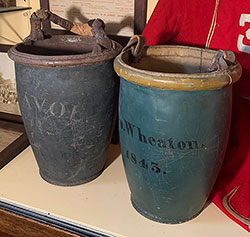
Leather Fire Buckets, c. 1803‑1834
Inscribed with: Samu’l Hicks 1803, Wm. Burr 1834, Davol 1812, and Munro 1811.
By an ordinance of the town of Warren, each householder was ordered to supply his house with two suitable fire buckets, which were generally of leather and in the shape of the one exhibited. The buckets were passed or thrown out to those persons who were on their way to the fire. The Burr family bucket was a gift of Misses Anne & Elizabeth Burr, Lyndon Street, Warren RI.
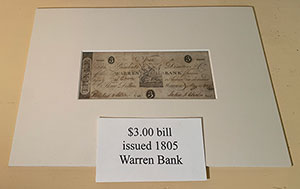
Warren Bank Collection
The Warren Bank was incorporated in October of 1803 as a holding company for the Warren Insurance Company, which dealt in marine insurance. By 1851 it was located on the southeast corner of Main and Market Streets. In 1865, it became the National Warren Bank until it was liquidated by the Industrial Trust Company, Warren branch. The building was replaced in 1906 by the building most recently occupied by Bank of America.

















